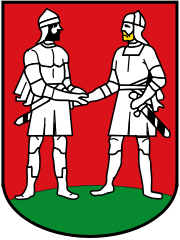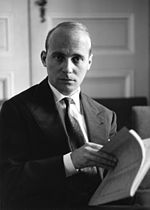Bünde
Bünde | |
|---|---|
Location of Bünde within Herford district  | |
| Country | Germany |
| State | North Rhine-Westphalia |
| Admin. region | Detmold |
| District | Herford |
| Subdivisions | 12 |
| Government | |
| • Mayor | Wolfgang Koch (CDU) |
| Area | |
| • Total | 59.30 km2 (22.90 sq mi) |
| Highest elevation | 175 m (574 ft) |
| Lowest elevation | 59 m (194 ft) |
| Population (2023-12-31)[1] | |
| • Total | 45,891 |
| • Density | 770/km2 (2,000/sq mi) |
| Time zone | UTC+01:00 (CET) |
| • Summer (DST) | UTC+02:00 (CEST) |
| Postal codes | 32257 |
| Dialling codes | 05223 |
| Vehicle registration | HF |
| Website | www.buende.de |
Bünde [ˈbʏndə] (Low German Buine) is a town in the Herford district, in North Rhine-Westphalia, Germany.
Geography
Bünde is situated between Osnabrück (west), Hannover (east) and Bielefeld (south).
Waterways
The town is crossed from west to east by the River Else, one of the few rivers in the world that does not originate from a spring, but as a result of bifurcation. It drains the whole area and discharges via the Werre and Weser into the North Sea. Within the town area it is joined by numerous small streams from the south and north. One of the northern streams is the Gewinghauser Bach, which on its way to the Else crosses water meadows in the district of Ennigloh-Gewinghausen. Other tributaries coming from the north in downstream order are the Ahler Bruchbach, which starts in Rödinghausen, flows mainly through the district of Ahler Bruch and enters the Else in the Melle area; in addition there is the Darmühlenbach, which also rises in Rödinghausen; then the Spradower Mühlenbach and finally the Eselsbach. From the south the Else is joined by the Werfener Bach.
Districts
The town is divided into 12 districts (Population numbers as of June 30, 2005):
|
|
International relations
Bünde is twinned with:=
 Jakobstad / Pietarsaari, Finland - since 1968
Jakobstad / Pietarsaari, Finland - since 1968 Leisnig, Germany - since 1990
Leisnig, Germany - since 1990
History
Bünde was first mentioned, as Buginithi, in 853.[2] It has one of the oldest church foundations of Westphalia, the 'Laurentius Church' (founded about 778 - 840). During the Cold War, it was home to a British military base (part of the BAOR) which closed in 1993.
Coat of Arms

The coat of arms of the city of Bünde features the two epic Germanic warriors Hengist and Horsa taking an oath and sealing it with a handshake. According to legend, two tribal Germanic chieftains (presumably of the Engern and the Saxons) joined forces in Bünde to conquer and settle in another country (Britanny). The name Bünde meaning bounds, (plural of bound). A neighbouring town of Bünde (about 10 km away) is the city of Enger which derives its name from the Engern (Angrivarii) tribe. After this tribal join, the Angrivarii where literally considered to be part of the Saxon confederation and not to be confused with the Angeln of Schleswig Holstein, however, the two tribes have the same Germanic root which may mean narrow (perhaps relation to a narrow estuary or Jutland) and it is possible that the Engern are an early split off group from the Angeln. However, the Engern are a tribe that already lived north of the Osning during the time of the Varus battle. They have had a longer presence in the area (then the Saxons) and were known as a fierce people, just like their neighbours, the Cheruscii. The English language term to be angry is possibly derived from this joined Engern and Saxon forces battle cries, beating their wooden buckler shields with axes and spears.
Natural history
About 30 million-year-old fossils were found in the Doberg, including a skull of a toothed whale (Easqualadon langewieschei) and a skeleton of a manatee (Anemotherium langewieschei). Both were found 1911-1912 by Friedrich Langewiesche, who became an honorary citizen of Bünde. The fossils are presented in 'Doberg Museum' in Bünde.
Industry
The main industries are kitchen furniture and cigar manufacturers. The town is called the Cigar Box of Germany. Many tobacco products such as pipes, and tobacco jars are also produced here. The Westphalian tobacco industry is based here, as well as the tobacco museums. Among companies based in the town, the model maker Revell is known on the international stage. The European arm has been based here since 1957.[3]
Culture
The town supports the Nordwestdeutsche Philharmonie for regular symphony concerts.
Notable Persons
- 1942, Gunter Gabriel, singer and lyricist
- 1949: Ulrich Horstmann, literary scientist and writer
- 1983, Aylin Tezel, actress and dancer
- 1984: David Odonkor, footballer
- 1996: Pascal Stenzel, footballer
Other personalities
The following personalities do not come from Bünde, but have worked or work in the city.

- Hengest and Horsa, according to the legend, these two Saxon tribe leaders and brethren (whose historicity is very controversial) forged the alliance in England
- Karl Koch (1875-1951), theologian, pastor in Ennigloh
- Hans Werner Henze (1926-2012), composer, spent some years of his childhood in the Bünder district of Dünne
- Fritz Pleitgen (born 1938), journalist, visited the Freiherr-vom-Stein-Gymnasium here and worked during this time for the then Freie Presse as a sports reporter;
- C. C. Catch (born 1964) (musician, real name: Caroline Gertrud Catherina Müller), musician, lived in Bünde for several years and attended school
- Maximilian Hecker (born 1977), musician, lived for many years in Bünde and did his Abitur at the Freiherr-vom-Stein-Gymnasium
- Andreas Hermann (born 1983), actor, lived in Bünde
Notes
- ^ "Bevölkerung der Gemeinden Nordrhein-Westfalens am 31. Dezember 2023 – Fortschreibung des Bevölkerungsstandes auf Basis des Zensus vom 9. Mai 2011" (in German). Landesbetrieb Information und Technik NRW. Retrieved 2024-06-20.
- ^ Adrian Room, Placenames of the World, 2nd ed. s.v. "Bũnde"; Franz Friedrich Roger Wilmans, Die Kaiserurkunden der Provinz Westfalen 777-1313: kritisch, topographisch, und historisch (Münster 1881) vol. II no. 189. p. 240; document of 1039.
- ^ Revell Company History cites 1957 for Bunde. See http://www.revell.de/en/company/history.html retrieved 21st September 2016.
-
Afterglow above Bünde
-
In Downtown Bünde
-
Lutheran church of "St. Laurentius"
-
tobacco storehouse (Tabakspeicher) and Central Bus station (German abbr.: ZOB)
-
The tobacco store house (Tabakspeicher)
-
The Train Station
-
German Tobacco- and Cigarmuseum
-
Monument of Tönnies Wellensiek










